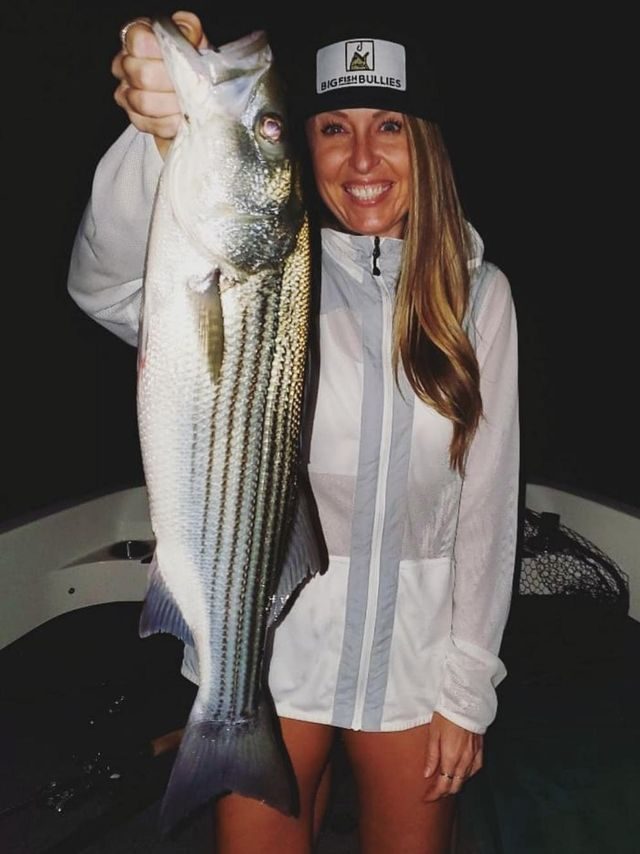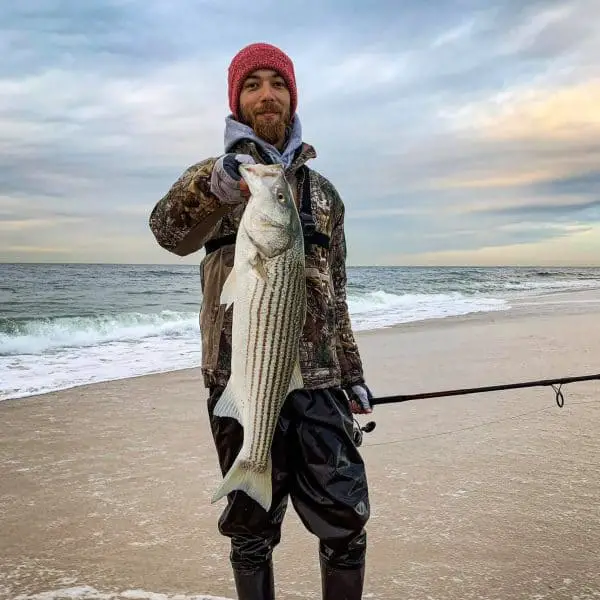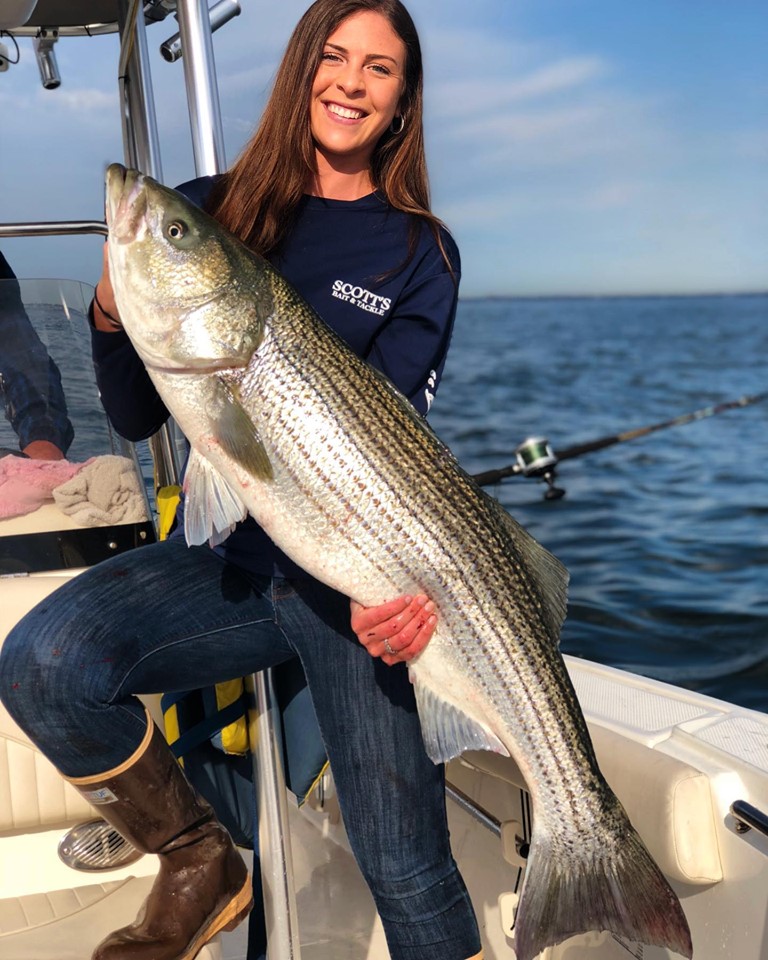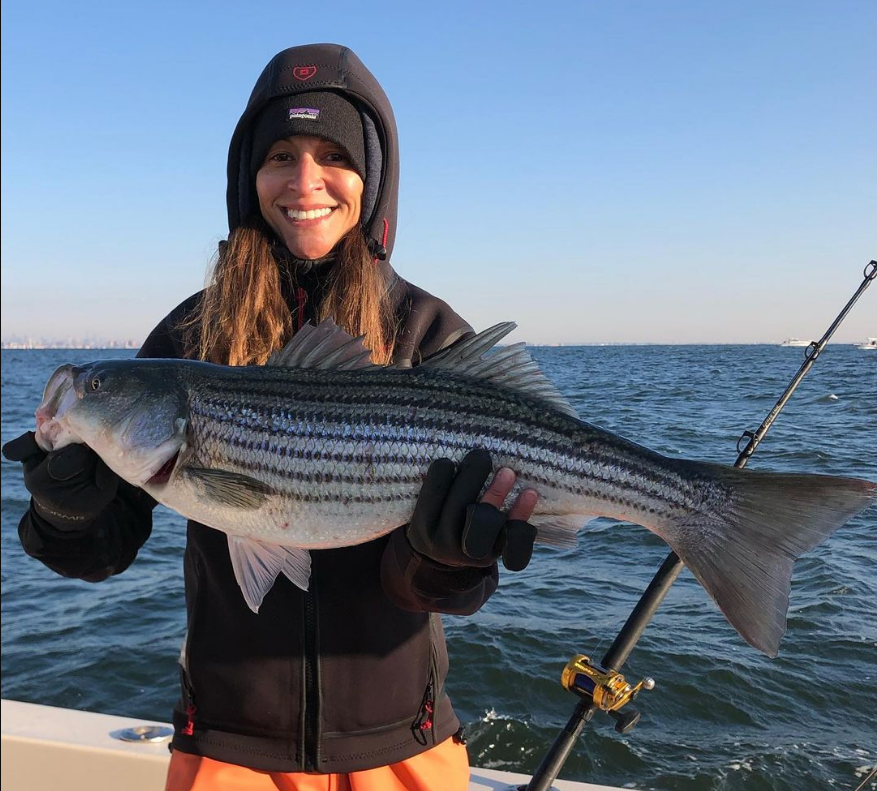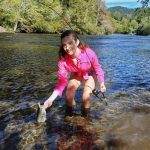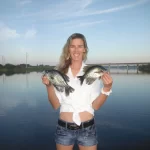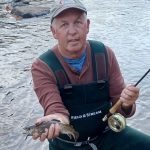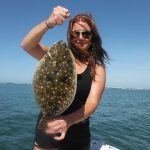Fishing for Striped Bass – Tips, Tackle, and Techniques
This article will thoroughly cover fishing for striped bass. Striped bass, also known as stripers and rockfish are an extremely popular game fish. They are a bit unusual in that they thrive in both freshwater and saltwater environments.
Striped bass, Morone saxatilis, are the most popular inshore saltwater game fish in the Northeast. They range from Maine down to South Carolina. Anglers fishing for striped bass catch them trolling, casting, using live bait, and surf fishing. They have also been transplanted successfully in many large freshwater lakes. There is also a population of striped bass in San Francisco Bay and the Sacramento River. They grow quite large with the world record being a touch over 80 pounds.
Fishing for striped bass
In salt water, striped bass are found from the mid Atlantic off of the Carolina coast north into Canada. Striped bass were also introduced into San Francisco Bay. In both of these saltwater environments, striped bass migrate up into freshwater rivers to spawn. On the East Coast, the Chesapeake Bay watershed and Hudson River host the majority of spawning striped bass. On the West Coast, the Sacramento River accomplishes this.
Striped bass have been introduced into many freshwater reservoir systems with great success. Most of these impoundments were created in the 1960s and 1970s and created fantastic largemouth bass fisheries. However, over the course of time much of the flooded timber has rotted and bass moved to man-made structure especially docks.
With so much open water available, striped bass and forage such as herring and shad were introduced into these waters. Striped bass flourish in these large lakes as they are mostly open water predators. Dams do restrict spawning in many of these lakes is restricted by dams, therefore striped bass are stocked regularly.
Striped bass habits
Striped bass are open water predators. They are most often found in fairly large schools. Striped bass have a varied diet and are opportunistic feeders. However, they primarily feed on bait fish, particularly herring and shad in freshwater and menhaden (bunker), herring, mackerel, sand eels, and other bait fish in saltwater.
Striped bass are often seen feeding on the surface. Anglers call this “breaking fish” and it is very exciting! Just about any flashy lure will draw a strike when fish are actively feeding like this. Trolling works well when striped bass are suspended below the surface.
Anglers do catch striped bass by casting lures and baits towards shoreline cover, mostly in saltwater situations. They will be found on bars and flats seeking forage. Striped bass can also be caught up in rivers as they migrate to spawn.
Best striped bass lures
The best striped bass fishing tackle varies, depending on the size of the fish and the technique being used. Medium spinning tackle works well for casting lures. A medium heavy baitcasting/conventional outfit is a good all-round choice. Heavy conventional tackle is required for trolling. Typical surf fishing gear works fine off the beach.
Spinning tackle is very versatile. It is the best choice for anglers casting lighter lures and smaller live baits for average sized striped bass in both fresh and saltwater. A 7′ medium action rod with a 3000-4000 series reel spooled up with 20 lb braided line is an excellent rod and reel combination.
Baitcasting tackle certainly has it’s place when fishing for striped bass. It works very well when casting heavier lures and live baits as well as having the power to handle a decent fish. A baitcasting outfit also works great for chunking, bottom fishing, and light tackle trolling. A 7′ to 7 ½’ medium heavy outfit with 30 lb braid works great.
Anglers can shop Amazon for Penn spinning and conventional combos
“Fishing Lido Key is a participant in the Amazon Associates Program, an affiliate advertising program designed to provide a means for sites to earn advertising fees by advertising and linking to Amazon. As an Amazon Associate I earn from qualifying purchases. ”
Anglers serious about striped bass fishing and seeking larger fish will need some heavy conventional tackle. This is used for trolling mostly, but can also be used to present live or cut bait to large fish. The venerable Penn 4/0 outfit works very well.
Surf fishing for striped bass is very popular for anglers all along the east coast. Standard surf fishing gear works fine and most anglers already have the proper equipment. For those that do not, a 12” medium heavy spinning outfit is a good place to start.
Striped bass fishing techniques
There are several techniques that are productive for anglers fishing for striped bass. These include drifting, trolling, casting lures, and bottom fishing. Some techniques even kind of cross over.
Drift fishing
Drifting can be an effective technique to locate and catch striped bass. This is particularly true in cooler water when striped bass are in deeper water, close to the bottom. This works well in saltwater where tidal flow will keep the boat moving. It can be used when freshwater fishing for striped bass as well.
Drift fishing is effective because it keeps the bait in the strike zone for the maximum amount of time while searching for fish. Live and cut bait are often used. However, anglers can vertically present a jig or spoon as well. The best spots to drift are ledges, sunken islands, wrecks and reefs, and near schools of bait.
Trolling for striped bass
Trolling is an extremely effective technique for catching striped bass. It allows anglers to cover a lot of water while presenting multiple baits or lures at various depths. One a particular pattern emerges, anglers can focus in on that bait and depth to catch a lot of fish.
Anglers can troll with both live bait and artificial lures. Slowly trolling a live herring or shad is the predominant method for taking big striped bass in freshwater lakes. Downriggers and sinkers are used to get the baits down to the desired depth. The boat is moved slowly, just enough to keep the lines straight. Channel edges are top spots as are any area where bait fish is plentiful.
Most anglers trolling for striped bass in saltwater use artificial lures. They can be trolled faster which helps anglers find the fish more quickly. Spoons, jigs, and plugs are all effective lures to use. Anglers should try to match the lure to the size of the available forage. Local tackle shops are an excellent source of information as to what lures produce in a particular area.
Plugs are great for trolling because no other gear is required, the lip on the plug will get it down in the water column. Spoons and jigs require trolling sinkers, downriggers, wire line, or planers. A trolling sinker followed by 10′ to 20′ of leader and then the lure is perhaps the easiest method. Planers work great as well, once an angler gets used to setting them.
Umbrella rigs are interesting rigs that are mostly used for striped bass fishing, though smaller versions are used by largemouth bass fishing (known as Alabama rigs). They allow anglers to present several lures at once. The rig mimics a school of bait fish, jigs are most often used. It is a bit cumbersome, but effective.
Fishing for striped bass with lures
Anglers fishing for striped bass can catch them casting lures as well. This is similar to other styles of fishing as anglers work a shoreline or flat while casting lures in search of fish. A lead head jig with a 4” to 6” soft plastic bait works very well. Plugs and spoons will also produce when blind casting. Many striped bass caught by anglers surf fishing do so casting lures.
As mentioned earlier, one of the most exciting striped bass fishing situations occurs when fish are found feeding on the surface. This occurs in both lakes and in saltwater. Bass “trap” the helpless bait against the surface and then feed aggressively. Birds are often a sign that feeding stripers are in the area.
Spoons, plugs, and jigs all work well in this situation. Anglers fly fishing can get in on the action as well. Fish really are not that fussy and will hit most lures that are presented well. The main factor to pay attention to is boat position. It is important to be as patient as possible and work the edges of the fish. Driving through the middle of them will often result in the striped bass going deep. Vertically jigging a spoon works great when this happens.
Fishing for striped bass with bait
Plenty of anglers fishing for striped bass do so using basic bottom fishing techniques. Fishing with live or cut bait on the bottom produces every saltwater species and striped bass are no exception. Bottom fishing with cut and chunk bait work very well for anglers surf fishing for striped bass.
Live bait works fine for bottom fishing, especially in saltwater, but cut bait is as productive and easier to use. Cut bait stays on the hook longer as well, which is an issue when crabs and bait-stealers are around. Any fresh caught fish that is legal to use will produce. Oily fish such as mackerel and menhaden are particularly effective.
Live bait is certainly used as well, but more often it is free lined or trolled as opposed to fished right on the bottom. These include herring, shad, menhaden, bloodworms, eels, and more. This technique works very well around bridges at night, some very large fish are caught doing this.
Fishing for striped bass in rivers
Many anglers enjoy fishing for striped bass in rivers. This is usually best in spring as stripers go on a spawning run. In lakes with dame, the fish often are forced to stop and school up at the tailwaters of dams. These can be fantastic fishing spots as fish are ganged up and forage comes through or over the dam.
While these are terrific spots, anglers do need to be very careful as currents can be strong. Drifting with bait or lures or casting lures will produce fish. Anglers can often fish these spots from the shoreline, eliminating the need for a boat.
Free flowing rivers will see striped bass migrating very far upriver, to portions where it becomes totally fresh. The major tributaries of the Cheasapeake Bay are important spawning grounds. The Hudson River sees a lot of striped bass as well. On the west coast, the Sacramento River gets a nice push of fish as well.
Drifting through deep holes is productive when fishing for striped bass in rivers. In slower moving rivers, trolling will also produce fish. As it shallows up, bumping a jig along the bottom works quite well.
Inlets are excellent spots to target striped bass. This is especially true for anglers without a boat, as most inlets have jetties which allow anglers access. The best time to fish inlets is generally on the turn of the tide, when the current flow is reduced. It is difficult to fish when the current is running hard through the inlet.
Anglers fishing the inlets can choose to use both natural and artificial baits. Those casting poppers and other plugs along with spoons and jigs do quite well when working parallel to the rocks. They will also make opportunistic cast whenever breaking fish pop up. Anglers bottom fishing need to constantly adjust the weight in order to minimize snags. Often times, the best spot to bottom fish is on the backside of the jetty where there is a sandy bottom and a current eddy.
Fishing for striped bass on the East Coast
Striped bass spawn in the brackish tributary rivers. Chesapeake Bay is responsible for about 80% of the striped bass spawning activity. The Hudson River in New York is second in that regard. Juvenile striped bass spend the first couple years in the freshwater and brackish rivers before migrating out to the open water. Striped bass can live up to 30 years old. Striped bass can be caught using a wide variety of angling techniques. They are caught drift fishing, trolling, sight fishing, chumming, fly fishing, and surf fishing.
Striped bass fishing tips
Anglers choosing to drift with natural bait will have success use in both live and cut bait. A free lined pogy or menhaden is a deadly bait for a trophy striped bass. Small live eels are used as well, especially in Chesapeake Bay around the bridges. Cut bait such as strips or chunks of fresh fish and squid will also produce. Anglers choosing to drift while using artificial lures will do well with jigs and heavy vertical jigging spoons.
Some anglers choose to anchor and chum a spot, rather than drifting it. This can be an extremely productive technique. The boat is anchored up on a drop off, piece of hard bottom, or other likely spot. Menhaden oil or other chum is dispersed with the tide from the stern. Several rods are rigged and hooked up with chunks of fresh baits such as pogy or menhaden. Any oily fish will work; bluefish and mackerel are fine baits. It is important to use circle hooks in this application to reduce the number of fish that are gut hooked. Many states require this by law.
Top east coast striped bass fishing spots
Striped bass fishing in Maine
Starting in the north, Maine now has reliable fishing for striped bass once again. After several down years, the numbers of fish are back up again. Biologists credit tough regulations along the east coast and plentiful bait fish as the main reasons for the resurgence.
Fish show in the the southern part of the state in May. They will move as far north as Penobscot Bay by late June. Mackerel, either live or in chunks, is a top striper bait. Any fresh cut bait will work at times. Sand worms and blood worms are also effective baits. Poppers, diving plugs, spoons, and jigs are the top choices for anglers who prefer artificial baits.
Striped bass fishing in Massachusetts
Striped bass show up off of Cape Cod and Buzzards Bay in late April and stay until fall. Smaller fish are usually first to show up, followed by the larger specimens. Massachusetts offers anglers fantastic striped bass fishing when conditions are right. Fish will be caught in Buzzards Bay, Cape Cod Bay, and off the area beaches.
Anglers fishing from boats catch striped bass trolling and drifting. However, the most exciting fishing is when schools of fish are “breaking” on the surface. Just about any lure will draw a strike. Surf fishing is extremely popular in this area as well. Cape Cod is famous for surf fishing for stripers and other species.
Striped bass fishing in New York and New Jersey
Long Island sound and the New York and New Jersey beaches offer fantastic striped bass fishing. Fish show up in mid April and stay until Thanksgiving. Anglers can target them by trolling, drifting, casting, and surf fishing. Sight casting to large fish in shallow water is great sport!
The fall blitzes off of Montauk are legendary. Fish will be seen busting on top throughout the area. Boating can be intense, especially on the weekends. The key to the fishing is the abundance of bait. This attracts the striped bass as they migrate through and they feed heavily, especially in the fall.
The Hudson River is responsible only behind Chesapeake Bay for producing juvenile striped bass. The fishing during the spring run can be epic. The prime time is from mid-April to mid-May. All of the same techniques produce in the river as in the saltwater.
Striped bass fishing the coast
Kirsten Holloway fishes the New Jersey Coast north of Atlantic City. As far as bass fishing on the Great Egg Harbor river goes, she catches fish on a variety of baits depending on the month of the year. In these pictures, the fish were caught in the spring time when the fish enter the river for spawning. At this time, the fish are after bloodworms and herring. Since the use of herring as bait has been outlawed, we have came up with some alternatives.
Most of these fish were caught as I like to refer to it as “chunkin”. I will use a hi-lo rig to catch a few smaller perch. I will then use the perch as bait and allow the bass to find the chunk, while staying anchored. It has seemed to work very well. If that isn’t working or I am looking to stay busy, I have also caught quite a few bass with a commonly used lure known as the “SP minnow” made by Daiwa.
Striped bass fishing, Chesapeake Bay
Chesapeake Bay is responsible for producing 80% of the east coast striped bass. The myriad of tributaries gives spawning fish plenty of places to reproduce. It also offers juvenile fish a place to feed and grow safely. Trolling produces most of the larger fish. Anglers can drift baits and lures as well as cast to fish.
Kayla Haile has been fishing the Susquehanna since before she could walk. Her dad would take her fishing there and taught Kayla everything she knows about fishing the river. She currently runs an 1860 G# jet boat. She primarily fishes the Susquehanna below the Cowingo Dam, but knows the Chesapeake Bay as well.
The Chesapeake Is a very diverse fishery. It starts as a river to the north and is almost like an ocean at the mouth. Tributaries hold juvenile fish before they migrate out into the open bay. Mature fish spawn in these rivers and creeks as well.
Striped bass fishing the Susquehanna River
Kayla fishes the lower Susquehanna River and flats below Cowingo Dam. The best fishing is in late spring when the water temperature is around 65°. She likes a 6’7″ medium heavy St. Croix rod, Diawa B&G reel spooled with 30 pound HI-SEAS Grand Slam Braided line.
Striped bass are mostly feeding on white perch at this time. Kayla has good success with a white Sassy Shad soft plastic swim bait on a 3/4 ounce jig head. This bait mimics the white perch that are in the river. Water clarity will affect bait choice. White or pearl is a great all round color. Most of the large striped bass are in shallow water. They put up a great and challenging fight around the rocks and other structure.
Fishing Chesapeake Bay
The entire Chesapeake Bay watershed can be productive. Numerous rivers will hold striped bass in the spring as they spawn. Larger rivers such as the Potomac, Rappahanock, Patuxent, and Choptank are normally best. The mouths of these rivers are good again in the fall. In the warmer months, most of the larger fish will be found in the main channel where the water is deeper.
Breaking fish are plentiful most years in the fall. Many of these are “schoolies” of around 20”, but are fun on light tackle. The late bite at the Chesapeake Bay Bridge Tunnel at the south end of the bay is legendary. Anglers also catch fish off the surf, especially near the inlets, during the season. Night fishing around the Bay Bridge can be very good.
Striped bass fishing in the Carolinas
Striped bass are plentiful as far down the coast as South Carolina. The Hatteras beaches in North Carolina are famous for surf fishing for striped bass and other species. These isolated barrier islands jut out into the Atlantic Ocean. Anglers come from all over the country to try their hand at surf fishing.
Most anglers surf fishing for striped bass take a two-pronged approach. They keep a 10 foot surf rod rigged up with a popper, plug, spoon, or jig. They they will also have a heavier 14 foot outfit. The heavier rig is baited up with a chunk of bait such as mullet or herring. While waiting for a bite, the lighter rod is used to cast whenever activity is seen.
Albermarle Sound and Pamlico Sound are large inshore bays that offer good striped bass fishing as well. Tributaries into the sounds as well as the inshore bays and rivers south to the Georgia state line offer good angling opportunities as well. The same techniques that work up north work well in both North Carolina and South Carolina.
Freshwater striped bass fishing
Striped bass are a huge success story in larger freshwater lake and river systems. As flooded timber has rotted, largemouth bass fishing slowed. Striped bass and herring were introduced, and the stripers flourished! This is particularly true in the Tennessee Valley Authority lakes throughout the Southeast. Dams often prevent spawning, however some sytems are free flowing. While the following article is about Lake Murray, SC, the tactics will work anywhere freshwater striped bass are found.
Lake Murray Striped Bass fishing, Tips and Techniques
This article will focus on catching Lake Murray striped bass. Lake Murray offers excellent fishing for these transplanted game fish, along with bass, catfish, crappie, and other species.
Lake Murray is a reservoir in the center of the state of South Carolina. It is 41 miles long and approximately 50,000 acres in size with around 500 miles of shoreline. Lake Murray was impounded in the late 1920s to provide hydroelectric power to the state of South Carolina. South Carolina were an innovator and began stocking striped bass in the late 60’s. Striped bass thrive in this freshwater fishery and are caught using several techniques.
Jacki Gillen is the “Lake Murray correspondent” for the site. She knows the lake well and primarily targets striped bass. Jacki was born in Norfolk, Virginia and grew up in the Lexington area of South Carolina. She spent many summers saltwater fishing with her grandfather in Chesapeake Bay along with freshwater fishing with her father in South Carolina.
Striped bass fishing fever!
It has only been in the last few years that she has found a new love for striped bass fishing with her husband on Lake Murray. Jacki also really enjoys offshore fishing and Charleston, South Carolina and in the Florida Keys. She owns J Hooker Fishing with her husband Jacob. Jacki is on the Striper Sniper pro staff and has great success using their products.
Striped bass are a saltwater game fish that were introduced into freshwater lakes in the early 70’s. Stripers spawn in freshwater and brackish rivers. Biologists were confident that they would do well in large freshwater lakes. They were correct! Striped bass do require fresh, flowing water to spawn. Santee Cooper is the only lake in South Carolina that has this environment. Therefore, Lake Murray striped bass do not reproduce. A million 1” fish are stocked each year.
Lake Murray striped bass forage
Striped bass feed primarily on bait fish. The primary forage species are threadfin shad followed by the gizzard shad. However, most and guides seem to prefer fishing with the blueback herring. These herring were not natural to Lake Murray, but were introduced by fishermen in 1985 and are now an established forage fish. Jacki does fine using herring and gizzard shad. Bait can be caught but Jacki prefers the convenience of picking it up at local bait shops.
The lures that Jacki uses and recommends when fishing for Lake Murray striped bass mimic these shad species in size and color. Bait size changes as they grow. Successful anglers “match the hatch” by keeping up with the size shad that the stripers are feeding on.
Lake Murray striped bass fishing tackle
Anglers need both spinning tackle and conventional tackle when targeting Lake Murray striped bass. Spinning tackle is used to cast to breaking fish (fish that are feeding on the surface) and for vertical jigging. Jacki prefers a 7 foot rod matched with a 3000-5000 series reel. She uses 20-30 lb braided line. No leader is required as the lure is tied directly to the braid.
Trolling requires heavier tackle. The strain of the larger lures and rigs dictates the use of light conventional equipment. Not to mention that there is always a chance to hook a very large fish as well as multiple fish at one time. Jacki uses 7′ rods, Penn 30 series conventional reels, and 50 lb test line on her trolling outfits.
Umbrella rigs are effective on Lake Murray striped bass
Umbrella rigs are very productive when trolling for Lake Murray striped bass. They can be a bit cumbersome and will tangle when multiple fish are hooked. Umbrella rigs are basically larger versions of the “Alabama rigs” that largemouth bass anglers have made popular. They do a great job of imitating a school of shad. Jacki prefers Capt. Mack’s un-rigged nine bait umbrella rigs. She pairs them all with Striper Sniper buck tail jigs, snake worms, and swim shad baits.
Striper Sniper 3/4 ounce to 1 ounce white buck tail jigs are tied on each arm of the umbrella rig. The leaders are 6 inches long. A Striper Sniper 10” snake worm or 6” swim bait is added to the jig for extra action. White, chartreuse, glitter, lemon lime, blue pearl, and sun drop are the top producing colors. They have recently introduced a new color called American eel which is next on the list to be tested
Lake Murray striped bass seasons
There are two basic seasons when fishing for Lake Murray striped bass; warm water and cool water. The water temperature is critical to striper migrations. Anglers need to be aware of this migration pattern and adjust accordingly. There is no real “calendar” as every year is different when it comes to weather. Here is Jacki’s advice for adapting to the two “seasons”.
Cooler weather striped bass fishing, fall and winter;
“Once the water temperatures begin to drop, the striped bass tend to start heading back towards the rivers and start coming up closer to the surface even schooling at the surface. We use umbrella rigs trolled at 3 MPH closer to the boat. This keeps them at or above 20 feet below the surface.
We also use planer boards with live herring trolled at about .5 – 1 MPH. We set the lines out 20-30 feet behind the planer. A 3 foot flourocarbon leader of 20-30 lb test is used. A # 3/0 hook completes the rig. We will occasionally run a flat line down the middle, quite a ways back.
Nothing beats casting artificial lures to breaking fish! I always keep a spinning outfit rigged with a topwater plug handy. My favorite bait is a Yo-Zuri 1 ounce plug. I use this when the fish are staying up on the surface. I also keep a Striper Sniper jig with a swim bait ready to go. This works well when fish surface quickly then go down. The jig will get down into the water column.”
Warm water striped bass fishing, spring and summer;
”Once the water begins to warm up, the striped bass start to head back to deeper water away from the rivers and towards the Lake Murray Dam. Anglers fishing in summer should always be able to see the dam. If not, you are too far away. We still use the umbrella rigs trolled at 3 MPH. However, we do so further from the boat to keep them in the 35 – 50 foot range, the lower the better.
We have also been able to put our smaller lighter weight rigs and crank baits on downriggers to drop them into the 60 – 80 foot range. Mid-Summer is also tower fishing season. We tie up to the towers at the Dam and drop live and/or cut bait herring typically to around 60 – 80 foot depths. We use a 1 ounce weight and a 3/0 hook.
Night fishing is a great way to escape the heat and catch some fish. Striped bass feed heavily at night, particularly in the summer time. Anglers do need to be more careful when fishing and boating in the dark. Summer storms can be an issue as well.
Additional Lake Murray species
While Jacki primarily concentrates on striped bass, Lake Murray offers excellent angling for other species. Largemouth bass are arguable the most popular species in the Lake. Much has been written about fishing for bass in the lake. Crappie and panfish are plentiful and Lake Murray has an excellent catffish population. Anglers can find more info and some great links about Lake Murray fishing in this link.
Sacramento striped bass fishing
This article will focus on Sacramento striped bass fishing. There are several rivers in the Sacramento, California area that offer anglers excellent fishing opportunities.
The Sacramento River is the largest river in California. Stretching over 400 miles from the eastern slopes of the Klamath Mountains to Suisun Bay, it drains an area of about 27,000 square miles, including many major fishing tributaries. The Sacramento River, The Delta, Mokelumne River, Feather River and the American River flow a short drive from Sacramento. They hold several different species including striped bass, salmon, largemouth and spotted bass, shad, catfish, and sturgeon. Anglers can target these species using several different techniques.
Aimee lives in Elk Grove, near Sacramento, and knows these rivers well. She fishes for a lot of species, both salt and freshwater. Her favorite species are Striped Bass and Salmon when fishing fresh water. While the rivers do offer decent bass fishing, Aimee enjoys the challenge, and great fish, of the larger fish.That is the reason that she targets Sacramento striped bass and salmon.
Striped bass fishing tackle
The same tackle can be used when targeting both species. Aimee only uses Phenix rods. Her personal favorite for casting is a 7’11” M1 Phenix rod with an extra fast action. She jigs with a 6’8” foot slow pitch Titan rod. She matches both with a Diawa Lexa reel and 65 lb braided line. When trolling, Aimee goes with a Phenix X-14 that is 7’11” with an extra fast action.
Heavy tackle is required to catch big fish in the current when targeting Sacramento striped bass and salmon. River and fishing conditions change daily. The best bet is to look online to get current river conditions and fishing reports. Aimee’s favorite sites for this are Navionics and Willy Weather.
Sacramento Striped Bass
Striped bass migrate up into these rivers in the spring to spawn. The best time to target them is from March to May in spring and October to December in the fall. As with most river fishing, water levels and flow are very important. Years that have more rain will see an extended season. Conversely, drought conditions will condense the fishing season.
When fishing for striped bass, Aimee uses a couple different techniques. She drifts live bait such as blue gill & minnows. This is a very effective technique and is one almost any angler can use to be successful. Mud sucker minnows are purchased at bait shops. Bluegill and shad are caught by anglers. Larger baits will get less bites but will catch bigger fish.
The rig that Aimee uses for drifting for striped bass is a simple drop back bottom rig. A 3 way swivel is tied on the line. Depending on current flow, sinkers from 2 ounces to 4 ounces. The sinker is placed on a 1 foot dropper line. A 4 foot leader of 15 lb to 30 lb test P-Line FlouroClear flourocarbon leader and a 2/0 to 7/0 hook completes the rig. As in most live bait applications, the hook size should be matched to the bait size, not the size of the fish being targeted.
Sacramento striped bass lures
Aimee really enjoys using artificial lures for these California river striped bass. She casts Delta Wood Bombers and ¾ ounce Ra-L-Traps. Silver/chartreuse, red and white, and chrome with a blue back are her top colors. Aimee also likes casting soft plastic swimbaits on a ¼ ounce or ½ ounce jig head.
Often times fish will be seen feeding on shad and other fish on the surface. This is a great time to cast a large topwater plug! Anglers can also blind cast both topwater and diving plugs neat fallen trees, rip-rap, and other structure and cover.
Trolling is another technique that produces striped bass on the California rivers. Her favorite plug is a Yo-zuri in the 5 1/4” size. Holographic Redhead is a great all-round color. Chartreuse woks well if the water is a bit murky. Trolling is relatively easy. Most anglers put the bow of the boat into the current and slowly work the area thoroughly. Fish are usually found in bunches, especially early in the year.
Artificial lure techniques on Sacramento rivers
Jigging is another very productive technique when targeting Sacramento River stripers. Aimee uses Blade-Runner Spoons for her jigging. Not surprisingly, her favorite color is “Aimee Blue”, named after her. You know she is a serious angler when she has baits named after her! 2 ounce to 3 ounce spoons are the preferred size.
The technique when drifting is fairly simple, whether jigging or using live bait. Anglers drop the lure or bait to the bottom and work it as the boat drifts along. Strong currents make it a bit more challenging. Channel edges and drop offs are prime spots, as are eddies when the river is running hard.
Anglers using live bait will need to adjust the depth of the bait as it drifts along. The idea is to keep the bait just above the bottom. Line will need to be let out and reeled in to adjust to the depth. Anglers jigging do the same thing, only the bait is jerked vertically as the boat moves along. The spoon should tick the bottom regularly.
Tennessee striped bass
Striped bass are a huge success story for the Tennessee fish management professionals. Many if not most of the Tennessee lakes were created in the mid-60s and early 70s by the TVA. These lakes had countless acres of flooded timber, offering perfect habitat for largemouth bass. However, over the years this timber rotted and deteriorated. Largemouth bass moved to other structure.
This left an opportunity for an open water fish species and striped bass were the perfect fit. The Tennessee state record of 65 lbs. 6 oz. caught in Cordell Hull reservoir is an excellent example of a thriving striper population
Striped bass are a saltwater species that can tolerate absolute freshwater. They naturally migrate from saltwater into freshwater rivers to spawn. While striped bass and lakes can reproduce, and most lakes they don’t. This is due to the fact that dams inhibit the migration of fish up into the tributary creeks and rivers.
Forage for striped bass
In order to support this new fishery, forage species needed to be introduced as well. Several different species of shad were introduced and have thrived as well. Shad school up in large numbers over underwater structure. These are the same places where striped bass are found.
Anglers targeting striped bass used two primary methods. Live or cut Shad produces the majority of striped bass by Tennessee anglers. Drifting, slow trolling, and bottom fishing with live baits is extremely productive. The biggest hurdle is catching and keeping the baits alive. Cut Shad will produce as well, though it will also attract large catfish.
Anglers casting artificial lures can catch striped bass as well. This is particularly true when they are found feeding on the surface. This is great fun as any spoon, crank baits, jig, or any other lure cast into the fray will normally draw a strike. Anglers vertically jigging deeper channel edges and blind casting shorelines and rip-rap areas near dams will also produce fish. Where allowed, tell water fisheries just below the dams can produce some fantastic striped bass fishing and Tennessee!
The top Tennessee striped bass fishing lakes are Old Hickory Reservoir, Cordell Hull Reservoir, Caney Fork, Melton Hill Reservoir, and Watts bar Reservoir.
Southwest striped bass
The southwest part of the country has excellent striped bass fishing as well, particularly in north Texas and Oklahoma.
Texas Striped bass lakes and rivers
The major lakes in Texas with healthy populations of stripers include Amistad Reservoir, Lake Texoma, Toledo Bend, Belton Lake, Canyon Lake, Cedar Creek Reservoir, Lake E.V. Spence, Cooper Lake, Hubbard Creek Reservoir, Lake Bridgeport, Lake Brownwood, Lake Buchanan, Lake Conroe, Lake Granbury, Lake Kemp, Lake Lewisville, Lake Livingston, Lake Lyndon B Johnson, Lake Palestine, Lake Ray Hubbard, Lake Somerville, Lake Tawakoni, Lake Travis, Lake Whitney, Lavon Lake, Medina Lake, Pat Mayse Lake, Possom Kingdom Lake, Proctor Lake, Red Bluff Reservoir, Richland Chambers Reservoir, Sam Rayburn Reservoir, and Wright Patman Lake. The Brazos River yielded the Texas state record striped bass.
Oklahoma Striped Bass lakes and rivers
The Oklahoma lakes and rivers that offer good striped bass fishing include Lake Eufaula, Broken Bow Reservoir, Canton Lake, Lake Murray, Waurika Lake, Fort Cobb Reservoir, Fort Gibson Lake, Grand Lake of the Cherokees, Great Salt Plains Lake, Hugo Lake, Kaw Lake, Keystone Lake, Lake Altus-Lugert, Lake Carl Blackwell, Lake Hudson, Lake Texoma, Oologah Lake, Robert S Kerr Reservoir, Skiatook Reservoir, Sooner Lake, Tom Steed Reservoir, and Webber Falls Reservoir. Most tributaries offer good fishing as well.
California striped bass lakes and rivers
The Colorado River used to support a spawning run of striped bass. This was prior to dame being built. Some large fish are still taken there. Productive California lakes include Lake Havasu, Pyramid Lake, Bucks Lake, Lake Mendocino, Los Vaqueros Reservoir, Millerton Lake, New Hogan Lake, San Luis Reservoir, The Delta, Canyon Lake, Castaic Lake, Diamond Valley Lake, Lake Cahuilla, Lake Hemet, Lake Elsinore, Lake Perris, Silverwood Lake and Skinner Reservoir.
Nevada Striped bass lakes
Lake Mead, Lake Lahontan, Washoe Lake, Lake Mohave, and Rye Patch Reservoir are the top Nevada striped bass Lakes.
In conclusion, this article on fishing for striped bass will help anglers be more successful when fishing for these terrific freshwater and saltwater game fish!
